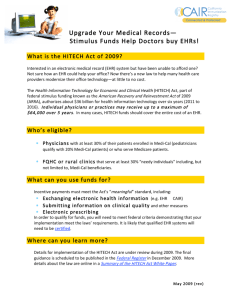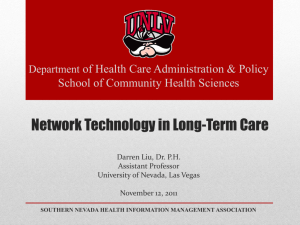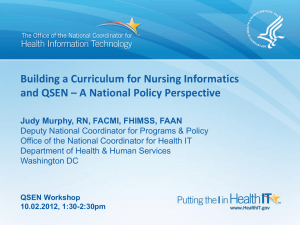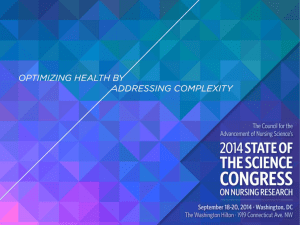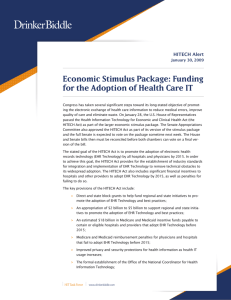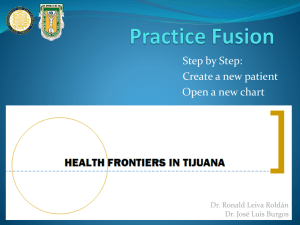Technologies
advertisement
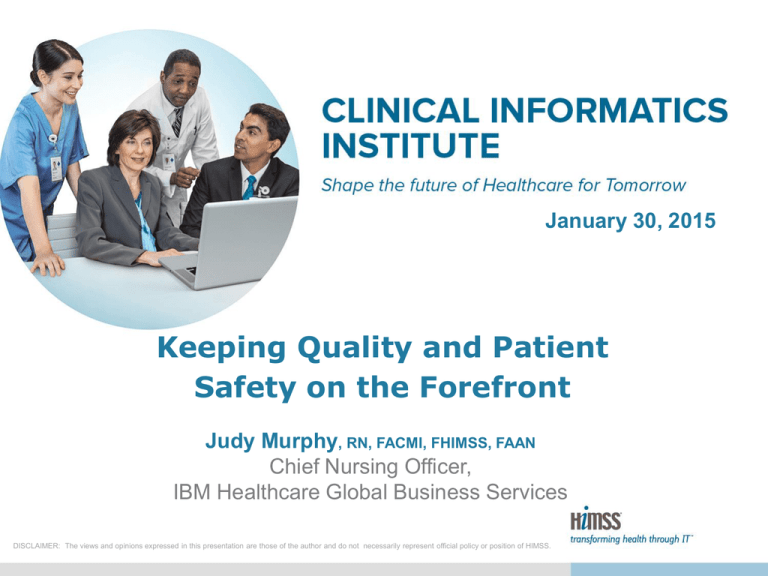
January 30, 2015 Keeping Quality and Patient Safety on the Forefront Judy Murphy, RN, FACMI, FHIMSS, FAAN Chief Nursing Officer, IBM Healthcare Global Business Services DISCLAIMER: The views and opinions expressed in this presentation are those of the author and do not necessarily represent official policy or position of HIMSS. Objectives • Review healthcare reform initiatives that focus on improving patient quality of care and safety. • Discuss how technology can enable or inhibit compliance with quality and patient safety standards and data-based decision making. What we will cover … • Quality and Safety Groundwork laid with the ARRA/HITECH legislation and MU Program • National Quality Strategy • Quality Improvement Cycle • The Learning Healthcare System • ONC Health IT Patient Safety Action and Surveillance Plan • Health IT Safety Center • FDASIA Report • SAFER Guides American Recovery & Reinvestment Act of 2009 (HITECH Act / Stimulus Bill) • 111th Congress • $787 Billion • Highly partisan vote • Healthcare portion = $147.7 Billion • • • • $87B for Medicaid $25B for support for extending COBRA $10B for NIH $19-22B for HealthIT HITECH = Health Information Technology for Economic and Clinical Health Five Broad Goals for “Meaningful Use” The vision for meaningful use is to enable significant and measurable improvements in population health through a transformed health care delivery system. The 5 overarching goals are as follows: 1. Improve quality, safety and efficiency 2. Engage patients and their families 3. Improve care coordination 4. Improve population and public health and reduce disparities in care 5. Ensure privacy and security protections Adapted from National Priorities Partnership. National Priorities and Goals: Aligning Our Efforts to Transform America’s Healthcare. Washington, DC: National Quality Forum; 2008. Staging/Maturation of the Meaningful Use Measures Improved outcomes Health Information Exchange EHR Adoption Stage 3 Stage 2 Stages of Meaningful Use Stage 1 Overall Value of the HITECH Programs • The EHR Incentive Program (Meaningful Use) has created a culture shift re: the automation of health care; a “tipping point” has been reached • The health care world is different today because we now have a national infrastructure – People – Technical • This national infrastructure has laid the groundwork to facilitate both care delivery reform and payment reform (ACA) Next Steps …. Meaningful Use as a Building Block Transform health care Improved population health Access to information Enhanced access and continuity Data utilized to improve delivery and outcomes Data utilized to improve delivery and outcomes Patient self management Patient engaged, community resources Care coordination Care coordination Patient centered care coordination Patient informed Evidenced based medicine Team based care, case management Basic EHR functionality, structured data Structured data utilized Registries for disease management Registries to manage patient populations Privacy & security protections Privacy & security protections Privacy & security protections Privacy & security protections Stage 2 MU PCMH 3-Part Aim ACO’s “Stage 3 MU” Utilize technology Stage 1 MU Our National Quality Strategy (3 Part Aim) Better Health for the Population Better Care for Individuals Lower Cost Through Improvement Six Priorities of the National Quality Strategy Making care safer by reducing harm caused in the delivery of care. Ensuring that each person and family are engaged as partners in their care. Promoting effective communication and coordination of care. Promoting the most effective prevention and treatment practices for the leading causes of mortality, starting with cardiovascular disease. Working with communities to promote wide use of best practices to enable healthy living. Making quality care more affordable for individuals, families, employers, and governments by developing and spreading new health care delivery models. Quality Improvement Cycle 11 Linking Measurement & Improvement eCQM Clinical Quality Improvement CDS The Learning Healthcare System • Build evidence out of practice • Leverage analytics to extract actionable knowledge 13 Set standards based on clinical goals, and evidencebased practice Leverage EHR to optimize workflow and support clinical decision making Measure the impact of the change through outcomes analysis and research Develop reports to monitor the practice change • Focus on “Making it Easy to do the Right Thing” • Collaborate to foster knowledge translation Best Care at Lower Cost The Path to Continuously Learning Health Care in America September 2012 iom.edu/bestcare 14 The Vision Continuous Learning, Best Care, Lower Cost 15 http://www.healthit.gov/policy-researchers-implementers/health-it-and-safety Original Plan (July 2013): http://www.healthit.gov/sites/default/files/safety_plan_master.pdf Update on the Plan (July 2014): http://www.healthit.gov/sites/default/files/ONC_HIT_SafetyProgramReport_9-9-14_.pdf 2 GOALS 1. Ensure the safe use of Health IT 2. Promote the use of Health IT to improve patient safety Health IT Safety Center FDASIA • Food and Drug Administration Safety Innovation Act (FDASIA) • Report on an riskbased Health IT Regulatory Framework that promotes innovation, protects patient safety, and avoids regulatory duplication. http://www.healthit.gov/sites/default/files/fdasiahealthitreport_final.pdf SAFER Guides: 9 guides to enable healthcare organizations to address EHR safety in a variety of areas http://www.healthit.gov/safer/ Thank you! For more information, contact: murphyja@us.ibm.com Keeping Quality & Patient Safety on the Forefront Mary Beth Mitchell, MSN, RN, BC, CPHIMS Chief Nursing Information Officer Texas Health Resources DISCLAIMER: The views and opinions expressed in this presentation are those of the author and do not necessarily represent official policy or position of HIMSS. Objectives • Explain a construct for identifying and managing safety issues impacting quality related to the electronic health record. • Provide specific use cases for defining safety concerns in the electronic health record related to workflow, culture, technology, and social interactions. Texas Health Resources res • 14 Wholly owned hospitals (25 hospitals total) • 18 outpatient facilities and • 250 other community access points • 3,100 Operational beds • 4,100 licensed hospital beds • 22,500 staff • 7,500 RN’s • 5,500 physicians • 557,785 annual emergency visits • 24,573 annual deliveries • More than 1.3 million inpatient & outpatient visits • 5 Magnet Hospitals • EMRAM Stage 7, Davies Award 2013 How Did We Get Here? Background HITECH: Catalyst for Transformation Paper records Pre 2009 A system plagued by inefficiencies HITECH Act 2009 EHR Incentive Program and 60 Regional Extension Centers ONC (2009). National Regional Extension Center HITREC Portal. Retrieved March 2010 EHRs & HIE 2014 Widespread adoption and meaningful use of EHRs 2 Islands of Communication Amcon Software, Inc. (2012). Nine tips to bring order to hospital communications chaos. www.amcomsoftware.com. 2 Improved Quality, Safety and Efficiency: What the HITECH Act is really all about … Better Communication and care coordination Faster Delivery of information and results Safer Treatment via e-Prescribing More efficient Coding and billing 28 ONC (2009). National Regional Extension Center HITREC Portal. Retrieved March. 2010 Safety Advantages • Well documented benefits of Electronic Health Record (EHR) – Legibility – Increased access to patient record – CPOE/Order Sets- evidenced based – ePrescribing – Data Analysis • Clinical decision support delivered electronically within the medical record will provide decision makers with tools for best practice and safety improvements. Harrison, Koppel, & Bar, (2007). Unintended Consequences of Information Technologies in Health Care- An Interactive Sociotechnical Analysis. JAMIA. 14: pp. 542-549 Hospital Information Technology Systems’ Impact on Nurses and Nursing Care Waneka and Spetz, JONA, December 2010 • Background: review of the literature to determine the impact of health information technologies (HITs) on nurses and nursing care • Study: Review of literature produced 564 references, of which 74 were selected for review to determine impact of HIT on nurses and Nursing Care • Results: Findings suggest that • HIT improves the quality of nursing documentation; • HIT reduces medication administration errors; • Nurses are generally satisfied with HIT and have positive attitudes • Nurse involvement in all stages of HIT design and implementation, and effective leadership throughout these processes, can improve HIT. • Conclusion: HIT has had positive influences on nurse satisfaction and patient care. Effective nursing leadership can positively influence the effective development, dissemination, and use of HIT. Radice, Barbara, (February, 2011). Informatics and Quality Outcomes. HIMSS Presentation, Orlando Florida. Patient Safety at THR 36% Reduction in Medication Errors 62% Reduction in Cardiac Arrest HIMSS Davies Case Studies, Texas Health Resources http://www.himss.org/ResourceLibrary/ContentTabsDetail.aspx?ItemNumber=26868 Safety Concerns with the EHR: Unintended Consequences of HIT • Events that are neither anticipated nor the specific goals of the associated [CPOE] computer project implementation • Includes both undesirable as well as desirable, positive, and beneficial consequences • Major categories of unintended consequences identified • May undermine patient safety practices, and cause delays, miscommunication, and even errors or harm to patients. • Often blamed on the performance of the “newly introduced technology.” Sittig and Ash. (2007). Clinical information systems: Overcoming adverse consequences. Boston: Jones and Bartlett. P. 30 32 Quality and Safety Related to Meaningful Use • EHR implementation can improve care delivery. Many experts, however, believe that too many systems are being installed too fast into environments too complex to be easily computerized. • In the frenzy to be eligible for federal EHR meaningful use incentive payments, and avoid reimbursement penalties starting in 2015, institutions may be setting themselves up for disastrous computerinduced medical errors • Ratio of patient care benefits to potential safety issues introduced by HIT approximately 10:1 • Efforts being made to ensure that the implementation of HIT is done as safely as possible • Majority of HIT related patient safety issues, when they occur, are related to preparation, training, and workflow changes Tietze, Mari, (2011). At Statewide Approach to HIT: Embrace the Technology, Preserve the Act. TNA Presentation, March 2011, Dallas Texas AMIA Health Policy Conference 2009 Bloomrosen, Starren, Lorenzi, Ash, Patel, & Shortliffe, (2011) Anticipating and Addressing the Unintended Consequences of Health IT and Policy: A Report from the AMIA 2009 Health Policy Meeting. JAMIA 18: pp. 82-90 A Construct for Quality and Safety in the EHR Several reasons identified for occurrence : Workflow Culture Technology Social Interactions Harrison, Koppel, & Bar, (2007). Unintended Consequences of Information Technologies in Health Care- An Interactive Sociotechnical Analysis. JAMIA. 14: pp. 542-549 Workflow • Order Management– Orders not always discontinued, or modified– Difficult to understand med dose, and IV rates. – Bad practices in placing order sets • Blood Administration • Medication Reconciliation • Blood Glucose Management Culture • Ignoring Alerts • Over-reliance on technology • Verbal orders/Telephone orders – Increased volume – Error prone – Alerts for physicians do not fire for nursing? – Order modes- correct co-signatures • Patient Hand-Offs/Communication • Lack of standardization within Nursing – Variability in hospital size and complexity – Variability of services- ie: Wound Care Technologies • CPOE • BMV- Barcode Medication Verification • Hard to Tell the Patient Story – Documentation in multiple places • Integration- with other systems – Device Integration – Disparate Systems • Downtime Management • Other technologies – Communication Devices – Fetal monitors Social Interactions • Lack of face-to-face communication – Physicians to nurses – Pharmacists to nurses • Perceived decreased socialization – Access and location of computers • Documenting at Nurses Stations How Can We Improve…… • Governance Clinician Organiza • Standardization Perform tional ance Efforts • Collaboration • Training and retraining • Workflow optimization National Initiatives • Operational reports • Front-line manager accountability • Improved communication between providers • Super Users, experts, commitment to support • Ensure good build, strong workflows Safe Clinician Use of EHRs • Know your organization’s approach to reporting • Promote a “just” culture for reporting of events to increase error reporting. Note: estimated that 1-5% of Health IT errors are actually reported • Know available resources to you and your organizations related to reporting patient safety issues with your EHR • Look for the trends in your events . . . these types of errors are more evident by their patterns than standing alone • Create a culture of patient engagement / activation 41 Framework for Monitoring and Evaluating EHRs for Safety 1. Ability for practitioners and organizations to report patient safety events or potential hazards related to EHR use; 2. Enhanced EHR certification that includes specific assurances that good software development procedures have been followed along with evidence that previously reported adverse events and hazards have been addressed; 3. Self-assessment, attestation, testing, and reporting by both clinicians and health care organizations that all 8 dimensions of safe EHR use have been addressed; 4. Local, state, and national oversight in the form of an onsite, inperson accreditation of EHRs as implemented and used by clinicians in the health care setting; and 5. A national EHR-related adverse event investigation board that reviews incident reports and has the authority to investigate. Walker, Carayon, Leveson, Paulus, Tooker, Chin, Bothe, & Stewart. (2008). EHR Safety: The Way Forward to Safe and Effective Systems. JAMIA, 15: 272-277 QUESTIONS
